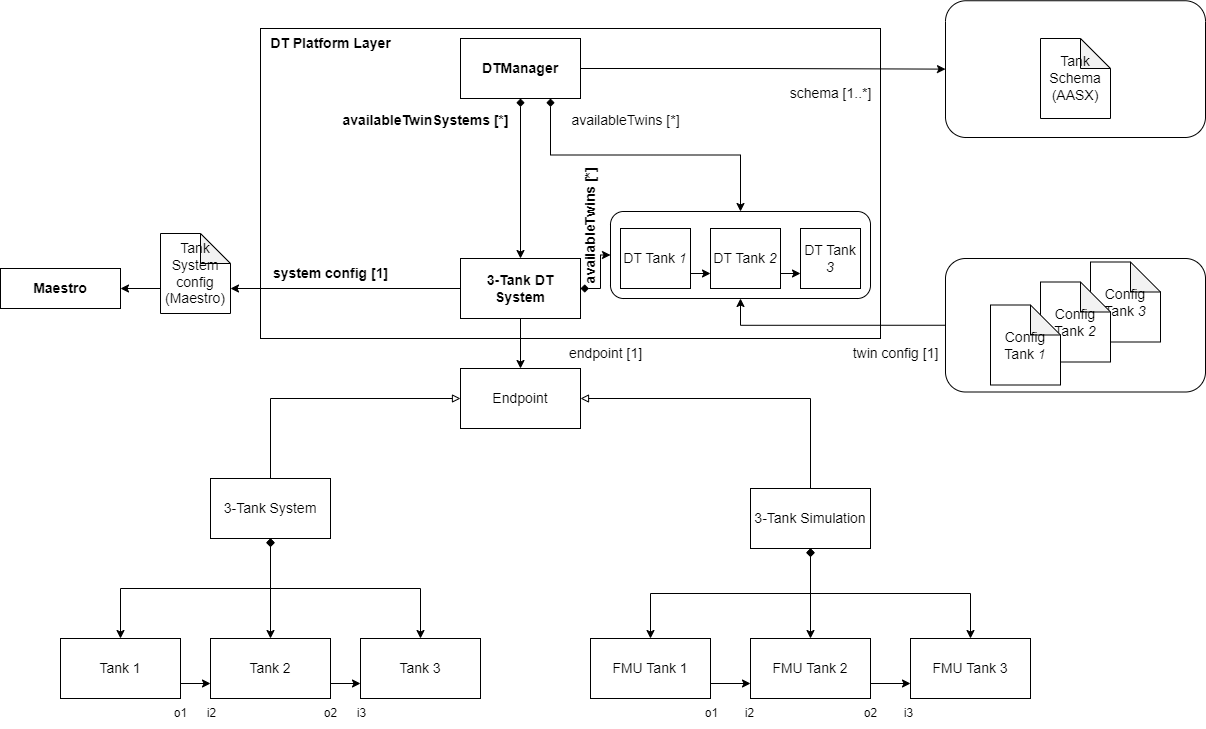Three-Tank System Digital Twin
Overview
The three-tank system is a simple case study allows us to represent a system that is composed of three individual components that are coupled in a cascade as follows: The first tank is connected to the input of the second tank, and the output of the second tank is connected to the input of the third tank.

This example contains only the simulated components for demonstration purposes; therefore, there is no configuration for the connection with the physical system.
The three-tank system case study is managed using the DTManager,
which is packed as a jar library in the tools, and run from a java main file.
The DTManager uses Maestro as a slave for co-simulation,
so it generates the output of the co-simulation.
The main file can be changed according to the application scope, i.e.,
the /workspace/examples/tools/three-tank/TankMain.java
can be manipulated to get a different result.
The /workspace/examples/models/three-tank/ folder contains
the Linear.fmu file, which is a non-realistic model for a tank
with input and output and the TankSystem.aasx file for
the schema representation with Asset Administration Shell.
The three instances use the same .fmu file and the same schema
due to being of the same object class.
The DTManager is in charge of reading the values from
the co-simulation output.
Example Structure

Digital Twin Configuration
This example uses two models, two tools, one data, and one script. The specific assets used are:
| Asset Type | Names of Assets | Visibility | Reuse in Other Examples |
|---|---|---|---|
| Model | Linear.fmu | Private | No |
| TankSystem.aasx | Private | No | |
| Tool | DTManager-0.0.1-Maestro.jar (wraps Maestro) | Common | Yes |
| maestro-2.3.0-jar-with-dependencies.jar (used by DTManager) | Common | Yes | |
| TankMain.java (main script) | Private | No | |
| Data | outputs.csv | Private | No |
This DT has multiple configuration files. The coe.json and multimodel.json are used by Maestro tool. The tank1.conf, tank2.conf and tank3.conf are the config files for three different instances of one model (Linear.fmu).
Lifecycle Phases
The lifecycles that are covered include:
| Lifecycle Phase | Completed Tasks |
|---|---|
| Create | Installs Java Development Kit for Maestro tool |
| Execute | The DT Manager executes the three-tank digital twin and produces output in data/three-tank/output directory |
| Terminate | Terminating the background processes and cleaning up the output |
Run the example
To run the example, change your present directory.
If required, change the execute permission of lifecycle scripts you need to execute, for example:
Now, run the following scripts:
Create
Installs Open Java Development Kit 11 and pip dependencies.
Also creates DTManager tool (DTManager-0.0.1-Maestro.jar) from source code.
Execute
Execute the three-tank digital twin using DTManager. DTManager in-turn runs
the co-simulation using Maestro. Generates the co-simulation output.csv file
at /workspace/examples/data/three-tank/output.
Terminate
Stops the Maestro running in the background. Also stops any other jvm process started during execute phase.
Clean
Removes the output generated during execute phase.
Examining the results
Executing this Digital Twin will generate a co-simulation output,
but the results can also be monitored from updating
the/workspace/examples/tools/three-tank/TankMain.java with
a specific set of getAttributeValue commands, such as shown in
the code.
That main file enables the online execution of the Digital Twin and its internal components.
The output of the co-simulation is generated to
the /workspace/examples/data/three-tank/output folder.
In the default example, the co-simulation is run for 10 seconds in
steps of 0.5 seconds.
This can be modified for a longer period and different step size.
The output stored in outputs.csv contains the level, in/out flow,
and leak values.
No data from the physical twin are generated/used.
References
More information about the DT Manager is available at: